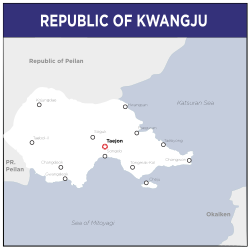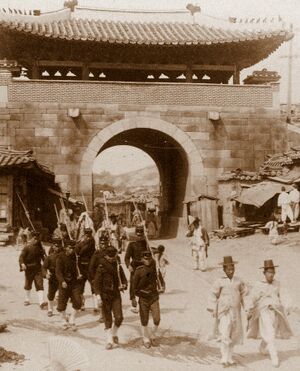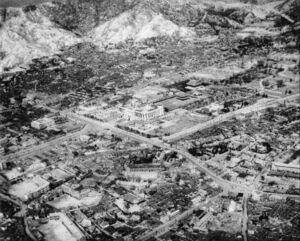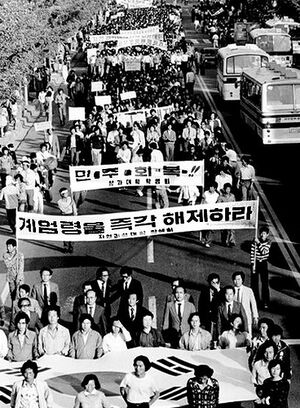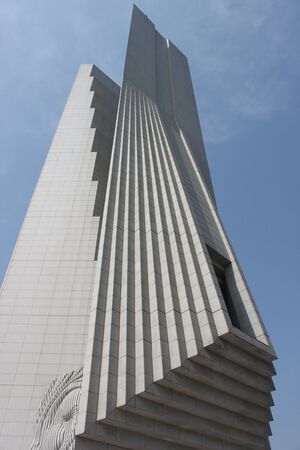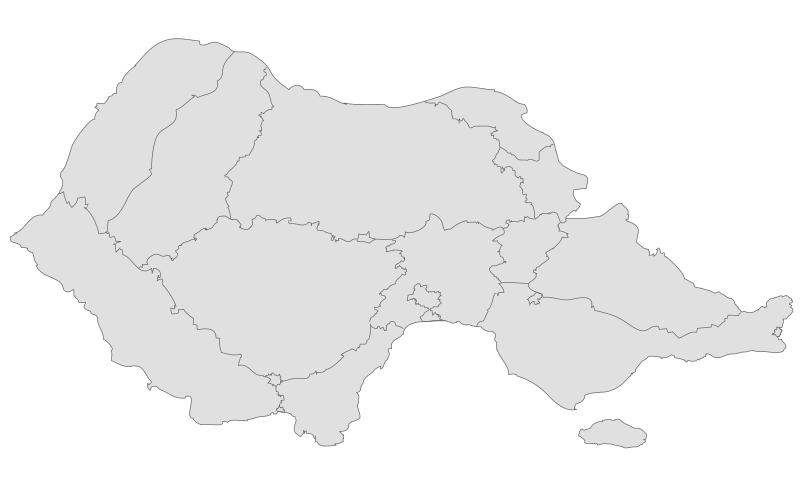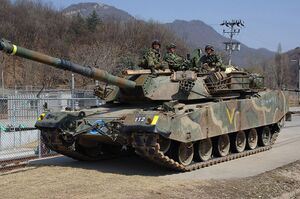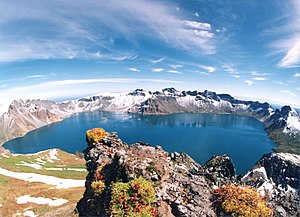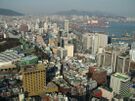Kwangju
| Republic of Kwangju 광주의 공화국 Gwangju Gonghwagug |
||||||
|---|---|---|---|---|---|---|
|
||||||
| Motto: 승리의 삶과 희망 Victory, Life, and Hope |
||||||
| Anthem: 아리랑 Arirang |
||||||
Major cities of Kwangju
|
||||||
| Capital | Taejon | |||||
| Largest city | (same as above) | |||||
| Official languages | Kwangju | |||||
| Recognised national languages | Trentannian | |||||
| Ethnic groups | 85% Kwangju 10% Sanese 5% Other |
|||||
| Demonym | Kwangju | |||||
| Government | Unitary parliamentary republic | |||||
| - | Prime Minister | Seo In-Daejun | ||||
| - | President | Lee Soo-man | ||||
| Legislature | National Assembly | |||||
| Independence from Mitoyagi | ||||||
| - | Liberation | September 9, 1952 | ||||
| - | Division | February 18, 1954 | ||||
| - | Reunification | April 23, 2013 | ||||
| Area | ||||||
| - | Total | 213,829 km2 82,560 sq mi |
||||
| - | Water (%) | 0.7 | ||||
| Population | ||||||
| - | 2014 estimate | 72,603,891 | ||||
| - | 2010 census | 68,549,283 | ||||
| - | Density | 330.18/km2 855.18/sq mi |
||||
| GDP (PPP) | 2014 estimate | |||||
| - | Total | §2,282,593,729,149 | ||||
| - | Per capita | §31,439 | ||||
| HDI (2012) | .909 very high |
|||||
| Currency | Kwangju Hwan (₩) (KWW) |
|||||
| Time zone | Kwangju Standard Time (UTC+9) | |||||
| Drives on the | right | |||||
| Calling code | +85 | |||||
| Internet TLD | .kw | |||||
Kwangju (광주 Gwangju, Officialy the Republic of Kwangju) is a parliamentary republic located in East Althena, bordered to the west by Morsco, and shares a sea border to the south with Peilan, and a sea border with Okaiken to the west. It comprises an estimated 70 million residents distributed over 213,829 km2 (82,560 sq mi), and the capital (and largest city) is Taejon, with a population of 10 million. Prior to its reunification, Kwangju was divided between the governments of the Kwangju DPR, Howan, and Seongpo. Kwangju has Adonia's sixth-largest economy by nominal GDP, and the world's fifth-largest economy by purchasing power parity. It is also Althena's fourth-largest economy. Kwangju's economy is driven by its exports, focusing on rare earth metals, electronics, robotics, shipbuilding, and automobiles. Kwangju is a member of the United Sovereign Nations, G20, South Cilician Mutual Assistance Treaty, and is a founding member of the East Althenian Sphere.
Archaeological evidence indicates that Kwangju has been inhabited as early as 10,000 BC. According to founding legends, Geunchogo, a descendant of heaven, founded Haemosu in 2326 BC, with it's capital at Mundeok (present day Chaegok). Following the fall of Haemosu to the Peilanese Pcing Dynasty, which installed the Jiasan Commandery on the peninsula, leaving many smaller kingdoms on the southern part of the peninsula. The largest of these, Kwanŭmdong drove out the Peilanese from the west in 320 AD, becoming the dominant force on the Kwangju Peninsula for the rest of its history. The remaining two kingdoms, Bamgogae and Tangsŏn remained constantly at odds with Kwanŭmdong over control of the peninsula. The three remained largely divided until 1901, when they were unified by Emperor Wŏnsingi, and formed the Kwangju Empire. The empire lasted until 1920, when it was annexed into the Mitoyagi Empire following the coerced Kwangju-Sanese Annexation Treaty. Near the end of the Great Adonian War Kwangju was liberated from Mitoyagi on February 14, 1952, and was occupied by anti-Imperial forces until the end of the war. Differences on how to govern Kwangju resulted in its partitioning, creating the Kwangju DPR, the Republic of Howan, and the Socialist Republic of Seongpo.
Etymology
The name Kwangju, comes from the words Gwang which means "light" and ju which means "province". This is most likely in reference to the renowned Festival of Lights that took place at Gyeonghuigung Palace (Palace of Serene Harmony) annually from it's construction until its destruction during the Sanese occupation of Kwangju.
History
Prehistory
Three Kingdoms
Kwangju Empire
The Three Kingdoms Period of Kwangju's history ended with the declaration of the Kwangju Empire at Geunchogo-Baekje Palace in Taejon, by Emperor Wŏnsingi in 1902. Wŏnsingi oversaw the modernization of Kwangju's military, industry, and education. The rapid modernization of Kwangju allowed the empire to spread its trade influence throughout East Althena, which was seen as a threat by Mitoyagi. Tensions between the Kwangju and Mitoyagi Empires continue to rise despite efforts by Emperor Wonsingi, and Mityoyagi Empire ultimately invaded Kwangju in 1917, and was annexed by Mitoyagi in 1920 following the Sanese capture of Taejon. Mitoyagi's control of Kwangju was reaffirmed with the Kwangju-Sanese Annexation Treaty of 1920.
Nation-wide resistance immediately followed in what was later called the the February 19th Movement, with the goal of establishing the Republic of Kwangju. The movement ultimately failed, and the government of Kwangju fled to Peilan, established the Provisional Government of Kwangju, where they continued to fight the Sanese occupation until the end of the Great Adonian War.
Sanese Occupation
The Sanese Occupation came to an end on 9 September 1952, when anti-Imperial forces entered Taejon to accept the Sanese Surrender, the soldiers were immediately greeted at the city gates by hundreds of thousands of people. The flag of the Mitoyagi Empire was lowered in front of the Sanese Government Building, before being taken away by the soldiers, and being replaced with the flag of Kwangju.
Division
Immediately following the end of the Great Adonian War, differences over how to govern Kwangju exploded into riots the country. The newly established Interim government of Kwangju struggled financially and politically to maintain order, and was unable to quell the riots. Allied forces made an agreement with Peilan to divide the peninsula in half between two military governments to oversee the recovery of Kwangju, and then hold joint elections to establish a unified government. Peilanese forces assumed authority over the eastern half of the peninsula to maintain order, and to help establish a new government. Peilan established the Democratic People's Republic of Kwangju, under the Worker's Party of Kwangju, headed by Myung Yu. The deadline for joint Kwangju elections to establish a new united government was ignored by the DPRK, and the Communist government broke off communication between the two states.
Fearful of the spread of Communism to the Republic of Kwangju, Republican forces were ordered by the Interim president, Jeong Yoon, to begin "preemptive apprehension" of accused communist supporters and guerrillas. Hundreds of thousands were detained by the government, and forcibly moved to Cheju Island, where they were executed.
However, Communist guerrilla attacks continued. Eventually Kwangju managed to reduce the numbers of guerrillas from 5,000 to 500, but it's military capabilities had been damaged. In the DPRK, this was seen as a chance for a swift forceful reunification of the two states, as the little remains of Kwangju's armed forces were deployed in the east, far from its border. On 13 March 1954, the first divisions of the Kwangju Liberation Army (KLA) crossed the border in Kwangju, sparking the Kwangju War. Significant gains for the Communist forces were made during the first year of the war, peaking with the capture of Taejon in June 1954. But the Communist advance was halted following the decisive Kwangju victory in the Battle of Taebyong River. Taejon was recaptured by the ROK Army in September 1955, after the decisive Battle of Songdo. Steady financial aid from International nations eventually allowed Kwangju to regain control . On and off again armistice negotiations began at Soguk, due to the near destruction of Taejon, and went to to continue for 3 weeks resulting in the Kwangju Armistice, which was signed at Pyeonghwama-eul (literally "peace village"), in the DPRK.
The signing of the Kwangju Armistice allowed the government to focus its military operations against the emerging Seongpo factions, which began the second phase of the Kwangju War. The government of Kwangju failed to crush the rebellion, leading to the establishment of the Socialist Republic of Seongpo, on the eastern end of the Kwangju Peninsula. A ceasefire that was called by the Seongponese to allow for the beginning of peace negotiations was accepted by Kwangju in late 1954. Despite the ceasefire, several clashes between Kwangju and Seongponese forces continued along the disputed border, resulting in several thousand deaths. Peace negotiations between Kwangju and Seongpo soon fell through due to the inability of either side to concede on the issue of POW exchanges. The President of Kwangju commited suicide on January 5, 1954, and the interim government of Kwangju collapsed. Seongponese forces then invaded Cheju Island destroying what little remained of it's defenses, and captured it. The collapse
Post-division
After the collapse of Kwangju, the Republic of Howan was founded in its place, under the leadership of Kim Suk-won. Under his leadership, Howan adopted a strict anti-communist position, and aggressive military policies. Lee Sung Ki also officially ended the war with Seongpo, though he continued to recognize only Howan as the sole legitimate representative of the Kwangju people. Relations between Howan and Seongpo greaty improved, as both had a common mistrust of the Kwangju DPR. In 1965 there was a brief period of warming relations following the exchange of POW's and the reunions of families separated during the civil war. However, this came to an end following a coup d'état in Howan overthrowing the First Republic of Howan, and establishing an autocratic government under the leadership of Seung Wook Yi. Wook-Yi, a strong conservative, embraced economic reforms, and the creation of a large military force.
As a result of Seung Wook Ki's economic policies, Howan's economy grew by an averga of 10% annually, surpassing that of both the Kwangju DPR and Seongpo combined. The rapid export driven growth of Howan's economy was eclisped by the brutal political repression under Seung Wook Ki, eventhough he led the government to develope the nation-wide expressway system, the Taejon subway system, and laid the foundation for the nation's future economic development. The rule of Seung Wook Ki came to an end during the Songdo Uprising, also known as the April 24th Uprising. Student protests who demanded the return of a democratic government to Howan camped out in Taejon's City Square, and staged marches and riots. Over time mounting violence and frustration forced Seung Wook Yi to resign, leading to the establishment of the Third Republic of Howan.
Tensions between Howan, Kwangju, and Seongpo flared up again after the Kwangju DPR testing its first nuclear weapon on March 18, 1979, under the name "Ganghan". The move was met with condemnation from the international community, and led to the restarting of Howan's nuclear weapons program. Weeks later several hundred Kwangju soldiers crossed the DMZ separating Howan and Kwangju, and attacked several guard stations, killing and injuring hundreds. The nuclear threat posed by the Kwangju DPR forced Howan and Seongpo to dig extensive tunnel systems for defense against a possible nuclear attack. The Kwangju Liberation Army Navy shelled several inhabited islands of Howan and Seongpo, most notably Nonmijŏm Island (Howan), which resulted in the deaths of 12 people, before Howanese ships arrived and chased off the ships.
Howan tested it's first nuclear weapon in 1983 under the name "Donghae", allegedly with help from the Republic of Peilan, an allegation in which both Kwangju and Peilan both denied. Taejon, Howan hosted the 1992 Summer Adonian Games, which the Kwangju DPR boycotted due to Howan's anti-communist laws and concerns about the safety of its athletes.
Reunification
Relations between the three states warmed considerably during the Sunshine Policy initiated by Seongponese President Park Sung Min. The three states agreed to reopen the joint Soguk Industrial Complex, where businesses could establish offices, and civilians from all three countries could find work. Around the same time the three agreed on new family reunification meetings between families that were separated during the war. Howan went as far as to offer to restart joint tourism projects, which had long been stalled due to the tense political climate on the peninsula. The offer was immediately rejected by the Communist Party of Kwangju, stating that the "political situation was not appropriate at the time", blaming the Howan and Seongpo for causing pro-democracy protests that were spreading through the country.
As the 19th National Congress of Kwangju convened, a suitcase bomb carried by Jae Yong exploded in the Assembly, killing both the Premier and President of Kwangju, along with several guards and MPs. In the chaos that followed, several similar attacks occurred against several other government buildings, including the National Security Commission building. In the Soguk Industrial Complex, Seongponese and Howanese companies were immediately pulled from the joint project on the orders from their respective government. However, the government of Kwangju refused to allow them to leave, trapping them in the complex. News of the deaths of several Communist officials reached the KLA at the DMZ, leading to several guards deserting their positions and fleeing across the DMZ into Howan and Seongpo. The lack of communication and the rush of people gave the impression of an invasion, causing a Howanese-Seongponese offensive against their eastern neighbor.
Howanese-Seongponese forces slowly advanced towards Changdeok, as they struggled to stem the overwhelming flow of refugees, along with resistance from forces of the Kwangju Liberation Army that remained loyal to the Communist Party of Kwangju. Several rebel groups arose in Kwangju with the backing of Howan and Seongpo with the goal of toppling the already weak and fractured Communist Party of Kwangju. The People's Republic of Peilan threatened to intervene in defense of the Kwangju DPR, but backed down with the deployment of nuclear capable Howanese submarines into the Sea of Mitoyagi. On 27 October 2012 the Kwangju Liberation Army seized power, killing the acting President of Kwangju, declared Changdeok an open city, before surrendering to Howan and Seongpo. A counter-coup was attempted, but ultimately failed due to lack of planning.
The Howanese/Seongponese forces entered Changdeok on 29 October 2012 to a cheering crowd. The Official Kwangju Instrument of Surrender was signed in the lobby of a hotel near the Great Hall of the People (National Congress). Reunification negotiations began in Okaiken, between Howan, Seongpo, and the joint occupation government of Kwangju. Due to the events prior to the negotiations, proposals from the Kwangju Occupation government were considered. A new constitution was approved by the three governments on April 23th, and the Republic of Kwangju was officially recognized on June 19, 2013.
Recent History
After the reunification of Kwangju, the Interim President announced general elections for 2014 to establish the new government of Kwangju. The Progressive Party of Howan and the Socialist Party of Seongpo merged on June 29th 2013, to form the Democratic Party of Kwangju, Kwangju's first official party. It was quickly followed by Grand National Party (also know as the Saenuri Party) quickly followed, through a merger of the Conservative Parties of Howan and Seongpo respectively. The Provisional government quickly passed the National Security Act, which effectively banned Communism in Kwangju, therefor rendering all Communist parties illegal.
The Democratic Party ultimately went on the win the elections, gaining 162 seats out of the 300 in the National Assembly. Seo In-Daejun was appointed Prime Minister, defeating his opponent Kyeong Ryeol. Lee Soo-man was elected President of Kwangju on 13 May 2014, defeating his conservative opponent, Park Myung-Ju. The Republic of Kwangju was recognized by both the USN and the Adonian Community on 19 June 2013, obtaining Howan's seat in both organizations.
Politics
Kwangju operates under a parliamentary system as a democratic republic with universal suffrage. A member of parliament supported by a parliamentary majority becomes the prime minister—usually this is the chair of the largest party. The prime minister is the head of government and head of the cabinet. Kwangju's current prime minister is Seo In-Daejun. Kwangju is governed by it's 300 member National Assembly. The president of Kwangju is head of state, with limited and largely ceremonial duties. The current president of Kwangju is Park Myung-Ju.
In the constitution of Kwangju, the state is sometimes referred to as the Second Republic of Kwangju.The government of Kwangju is outlined by the Constitution of the Republic of Kwangju, which establishes the judicial, executive, and legislative branches of government. The current constitution of Kwangju is deprived from that of the First Republic of Howan, and thus the content has only been revised once, during the military dictatorship of Seung Wook Yi, who abolished the positions of prime minister and president.
The first direct elections in the history of Kwangju were in 1979. Although South Korea experienced a series of military dictatorships from the 1960s up until the 1980s, it has since developed into a successful liberal democracy. Kwangju is now described as a "full fledged democracy", with civil liberties entrenched in its constitution.
Political Parties
Kwangju has a multi-party system, in which several political parties have a chance to gain power. However, The two major parties of Kwangju are the Democratic Party, and the Grand National Party. The Democratic Party is currently in power in Kwangju, holding the Presidency, Prime Minster, and a majority in the National Assembly (162 out of 300 seats). There are no communist parties in Kwangju, due to the criminalizing of "Far-left politics" in the National Security Act. Minor parties include the Labor Party, the Justice Party, and the Green Party.
Human Rights
Human rights are protected by the Consitution of the Republic of Kwangju, irrespective of religion, sex, or ethnicity. Kwangju is considered one of the most liberal countries in East Althena, particularly when compared to its neighbor, the People's Republic of Peilan. However Kwangju's protection of basic rights has been thrown into doubt with the passing of the National Security Act, which gives the government the right to arrest someone under the suspicion of being Communist, or a sympathizer of communism.
The law is a source of in the Democratic Party, with its members unable to form an united view on the law due to conflicting views within the party. By some it is seen as the potential restriction of the freedom of speech, but it seen as others as essential in the nation's stability. Polls show that more than half of the Kwangju public are against abolishing the act.
Elections
The political system of Kwangju has two types of elections: general elections to the National Assembly held every four years (unless it is dissolved earlier), and local elections held every four years for offices in both provinces and municipalities. Elections are supervised by election committees at each administrative level under the general direction of the Central Election Administration Committee, an attached organization to the Ministry of Internal Affairs and Communications (MIC).
- Legislative elections
| National Assembly | The Majority | The Minority | Prime Minister | |||||
|---|---|---|---|---|---|---|---|---|
| Position | Party/Coalition | Seats won | Name | Tenure | Position | Party | ||
| 1st (2014) | Liberal | Democratic Party | 162 / 300 | Grand National Party | Seo In-Daejun | 2014-Present | Liberal | Democratic Party |
- Presidential
| Election | Candidate | Total votes | Share of votes | Outcome | Party Name |
|---|---|---|---|---|---|
| 2014 | Lee Soo-man | 18,829,783 | 56.0% | Won |
Democratic Party |
Administrative divisions
Kwangju is divided into 12 provinces (do), 1 special autonomous province (teukbyeol jachido), 5 metropolitan cities (gwangyeok-si), and 1 special city (teukbyeolsi). These are further subdivided into a variety of smaller entities, including cities (si), counties (gun), districts (gu), towns (eup), townships (myeon), neighborhoods (dong) and villages (ri).
| Namea | Kwangju | Populationc | |||||||||||||||||||
|---|---|---|---|---|---|---|---|---|---|---|---|---|---|---|---|---|---|---|---|---|---|
| Special city (Teugbyeolsi)a | |||||||||||||||||||||
| Taejon | 서울특별시b | 10,233,918 | |||||||||||||||||||
| Metropolitan cities (Gwangyeogsi)a | |||||||||||||||||||||
| Changdeok | 부산광역시 | 5,650,000 | |||||||||||||||||||
| Chongwon | 대구광역시 | 6,730,000 | |||||||||||||||||||
| Songan | 인천광역시 | 2,879,782 | |||||||||||||||||||
| Sejong | 광주광역시 | 1,472,910 | |||||||||||||||||||
| Taegu | 대전광역시 | 1,532,811 | |||||||||||||||||||
| Special self-governing city (Teugbyeol-jachisi)a | |||||||||||||||||||||
| Soguk | 세종특별자치시 | 122,153 | |||||||||||||||||||
| Provinces (Do)a | |||||||||||||||||||||
| Taebyong | 강원도 | 1,542,263 | |||||||||||||||||||
| North Paegunson | 충청북도 | 1,572,732 | |||||||||||||||||||
| South Paegunson | 충청남도 | 2,047,631 | |||||||||||||||||||
| Daenaru | 전라북도 | 1,872,965 | |||||||||||||||||||
| Kwangdauel | 전라남도 | 1,907,172 | |||||||||||||||||||
| Naechoon | 경상북도 | 2,699,440 | |||||||||||||||||||
| Kaejae | 경상남도 | 3,333,820 | |||||||||||||||||||
| Kuyangdo | 경상남도 | 3,333,820 | |||||||||||||||||||
| Namsan | 경상남도 | 3,333,820 | |||||||||||||||||||
| Myongsong | 경상남도 | 3,333,820 | |||||||||||||||||||
| Taenonggok | 경상남도 | 3,333,820 | |||||||||||||||||||
| Tongnam | 경상남도 | 3,333,820 | |||||||||||||||||||
| Special self-governing province (Teugbyeoljachi-do)a | |||||||||||||||||||||
| Cheju | 제주특별자치도 | 987,000 | |||||||||||||||||||
Foreign Relations and Foreign Aid
Kwangju maintains diplomatic relations with 190 countries. The country has also succeeded the Republic of Howan's seat in the United Sovereign Nations, which it had held since 1978, when it became a member state at the same time as the Kwangju DPR and Seongpo. Kwangju and his predecessor states have also hosted major international events such as the 1992 Summer Adonian Games and the G-20 summits. Kwangju is a member of the United Sovereign Nations, WTO, East Althenian Sphere (EAS), and G-20 major economies. It is an important member of the Adonian Community, and a founding member of the East Althenian Sphere.
Kwangju is currently involved in several disputes with its neighbors: with Okaiken over the Mokpo Islands (currently administered by Kwangju), and the People's Republic of Peilan over 160 km of land surronding Mountain, which was passed on from the Kwangju DPR following the reunification of Kwangju. Kwangju is also an active member of the South Cilician Mutual Assurance Treaty.
Kwangju has continuously been a major contributor of emergency relief and troops to regions affected by conflict and natural disasters in the developing world, along with peacekeeping missions. The main Kwangju governmental agency for foreign aid is the Kwangju Fund for Development (KFD) which traces its roots back to Howan in the 1980s. Since its establishment, the KFD has provided almost §6.7 billion in soft loans and grants for developing countries mainly in Neridea and East Althena.
Military
Kwangju's long history of war and unsolved disputes with its neighbors has lead Kwangju to develop a large, modern armed forces. The Reunification of Kwangju merged the armed forces of Howan, Seongpo, and the Kwangju DPR and reorganized them into the Republic of Kwangju Armed Forces. Consequently, Kwangju has the world's ???th largest number of active troops (885,000), the world's ???th largest number of reserve troops (5,900,000), and the 7th largest defense budget (§47 billion). The ROK military is becoming increasing active in international peacekeeping operations. The ROK Armed Forces depends on a large variety of equipment produced by both domestic and foreign manufactures. The largest domestic supplies to the ROK Armed Forces are the Buryeo Group, and Eunjin Rotem, in which the latter produces Kwangju's main battle tank, the K2 55-Tank. The merging of the armed forces of Howan, Seongpo and the Kwangju DPR have left the ROK Armed Forces with an extensive variety of equipment and weapons, including several Peilanese made tanks and aircraft.
The Kwangju military consists of the Army (ROKA), the Navy (ROKN), the Air Force (ROKAF), and the Marine Corps (ROKMC), and reserve forces. Most of these forces are concentrated near the border with the People's Republic of Peilan. All Kwangju males are constitutionally required to serve in the military, usually atleast 12 months, with no exceptions.
As a recognized nuclear weapons state, Kwangju is considered a major regional military power. The government of Kwangju has not disclosed a exact number, but Kwangju is estimated to maintain between 450 and 1,000 nuclear warheads. Due to Kwangju's proximity to the People's Republic of Peilan, and its numerous disputes with neighboring states, it has developed numerous power projection assets – a series of helicopter carriers, and it maintains a substantial fleet of submarines, including several nuclear-powered attack and ballistic missile submarines.
The Republic of Kwangju Army has 5,450 tanks in operation, including the K1 55-Tank and K2 Black Panther, which form the backbone of the ROK Army's mechanized armor and infantry forces. A sizable arsenal of many artillery systems, including 1,700 self-propelled K55 and K9 Thunder howitzers and 720 helicopters and UAVs of numerous types, are assembled to provide additional fire, reconnaissance, and logistics support. The Republic of Kwangju Air Force is currently looking into the development of smaller, more advanced UAVs.
The ROK Navy's transformation into a blue-water navy came after the establishment of the Strategic Mobile Fleet, which includes a battle group of Chungmugong Yi Sun-sin class destroyers, Dokdo class amphibious assault ship, 84 submarines, and Emperor Wŏnsingi class destroyers, which is equipped with the latest fleet-defense system that allows the ships to track and destroy multiple cruise missiles and ballistic missiles simultaneously, forming an integral part of Kwangju's indigenous missile defense umbrella against the PR Peilan's missile threat. The Republic of Kwangju Air Force operates 1,003 aircraft, making it world's fifth largest air force, including several types of advanced fighters.
Geography
Kwangju is located on the Kwangju Peninsula in East Althena. Kwangju is separated from Peilan by the , while the Paeku Mountains separate Kwangju from the People's Republic of Peilan. The Sea of Mitoyagi is to the south, and the Katasuran Sea is to the east. Important islands in Kwangju include Cheju, the Mokpo Islands. The Saeng (Wild) River runs south from its several tributaries in the center of the Kwangju Peninsula, south through Taejon and Sejong, into the Sea of Mitoyagi.
The north and eastern parts of Kwangju are mostly made up of fertile plains fed by small lakes and streams, while the south and western parts are more mountainous. The tallest mountain in Kwangju is Baekdu Mountain (2,744 m), which is disputed between Kwangju and the People's Republic of Peilan. The southern extension of Mount Paektu is a highland called Gaema Heights. This highland was mainly raised during the Cenozoic orogeny and partly covered by volcanic matter. To the south of Gaema Gowon, successive high mountains are located along the eastern coast of the peninsula. This mountain range is named Paekdudaegan. Some significant mountains include Mount Sobaek or Sobaeksan (1,439 m), Mount Kumgang or Kumgangsan (1,638 m), Mount Seorak or Seoraksan (1,708 m), Mount Taebaek or Taebaeksan (1,567 m), and Mount Jiri or Jirisan (1,915 m). There are several lower, secondary mountain series whose direction is almost perpendicular to that of Paekdudaegan. They are developed along the tectonic line of Mesozoic orogeny and their directions are basically northwest.
Unlike most ancient mountains on the mainland, many important islands in Korea were formed by volcanic activity. Cheju (Cheju-do) Island, situated off the southeastern coast, is a large volcanic island whose main mountain Mount Sanllaes (1950 m) is the second highest in Kwangju, after Baekdu Mountain. The volcanic islands tend to be younger than the Kwangju mainland.
The southern and southeastern coastlines of Kwangju are very complex, and are known as Dadohae-jin in Kwangju. Its convoluted coastline provides mild seas, and the resulting calm environment allows for safe navigation, fishing, and seaweed farming. In addition to the complex coastline, the southern coast of the Kwangju Peninsula has an extremely high tidal amplitude (at Sejong, around the middle of the western coast. It can get as high as 9 m). Vast tidal flats have been developing on the south and north coastlines.
Flora and Fauna
The Kwangju Peninsula is home to over 500 species of birds, and more than 3,000 different species of plants.
Economy
Kwangju's economy ranks 5th by purchasing power parity (PPP), identifying it as one of the G-20 major economies. It is a developed country with a high-income economy and is one of the most industrialized nations in East Althena. Kwangju's economy is export driven, and is extremely diversified. The largest portion of Kwangju's exports, electronics, only makes up 9.1% of Kwangju's total GDP.
During the division of Kwangju, Howan's economy was one of the world's fastest-growing from the early 1960s to the late 1990s, and Howan was a founded member of the WTO, along with the East Althenian Sphere, in pursuit of free trade and expanded exports. Kwangju is ranked 7th in the world in total exports, and 8th in imports, respectively. Kwangju's economy has remained highly dependent on international trade, as it is a mainly export driven economy. The economy of Kwangju remained largely unaffected by recent economic slowdown in the world economy, maintaining a growth rate of 3.8%.
The vastly unexploited rare metal deposits in eastern Kwangju has an estimated worth of over §6 trillion in today's currency. with the unification of Kwangju, it is predicted that it could overtake several of the world's largest economies within 10 to 20 years.
Infastructure
Kwangju has a very advanced and modern infrastructure, which has been expanding since the 1960s. Both the Kwangju government and the private sector are involved in the financing, construction, and operation of various infrastructure projects and services. The government is expected to spend well over §300 billion on the construction airports, railways, and roads/highways. Major cities in Kwangju suffer from heavy traffic due to rapid population growth and severe overcrowding. The government has responded with increased funding for public transport, and expanding current transportation systems.
Major international airports include Sejong National Capital Airport, Chongwon International Airport, Cheju, and Changdeok. The fast growth of Kwangju's economy has added to the pressure on Kwangju's ports, especially Sejong Port, which is currently the world's largest port by area, and the world's busiest by cargo tonnage.
Energy
The Kwangju Electric Corporation (KEC), also known as KECO, is the main provider of electricity in the country. Production reached 73,992 million kwhr in 1987. In 1987, residential customers used 17.9% of total production, public and service businesses, 16.2%, and the industrial sector, 65.9%. Sources of power generation were primarily nuclear power, coal, oil, and liquefied natural gas. Of the 54,885 million kwhr of electricity generated in 1985, 22% came from nuclear plants then in operation, 74%, from thermal plants (oil and coal), and 4%, from hydroelectric sites. It was predicted in 1988 that the generation structure by the year 2000 (when Reunification was predicted to happen) would be 10.2% hydroelectric, 12.2% oil, 22.9% coal, 10.2% LNG, and 44.5% nuclear. More recent statistics:
| Source | 2008 | 2009 | 2010 | 2011 |
| Hydro | 264,747 (62.7%) | 278,400 (64.2%) | 315,608 (66.5%) | 324,354 (65.3%) |
| Nuclear | 150,958 (35.7%) | 147,771 (34.1%) | 148,596 (31.3%) | 154,723 (31.1%) |
| Thermal | 5,561 (1.3%) | 5,641 (1.3%) | 6,472 (1.4%) | 7,831 (1.6%) |
| Other | 1,090 (0.3%) | 1,791 (0.4%) | 3,984 (0.8%) | 9,985 (2.0%) |
| Total | 422,355 | 433,604 | 474,660 | 496,893 |
Transport
Kwangju possesses an advanced transport network consisting of high-speed railways, highways, bus routes, ferry services, and air routes covering most of the Kwangju Peninsula. All transportation in Kwangju is handled by the Ministry of Transportation. The first high speed rail system in Kwangju was built in 1973 in Howan by the Howanese High Speed Rail Commission. It was later followed by Kwangju DPR in 2002, and Seongpo in 2003. The Inter-Kwangju Railroad was completed in 2009, featuring a continuous high speed rail system.
The most common way of traveling in Kwangju remains driving, despite signifigant increases in rail and air travel. Much of contemporary Kwangju's transport systems have been built since the Division of Kwangju. Prior to 1956, transport was limited to dirt roads besides in Taejon, but even those were in poor condition. The development of the Howanese Highway system by Seung Wook Ki was essential in the economic growth of Kwangju from the 1960s to the 1990s. In 2013, Kwangju had 110,293km of roads, along with 68,520km of highways. Rail travel has become the second most common form of transport, although air travel has also experienced significant growth since the late 1990s. The Inter-government-led effort — that began in the 1990s — to connect the country by expressways via the "Inter-Kwangju Highway System" has resulted in the rapid expansion of the system, which now connects all the major cities of Kwangju.
Kwangju has almost 4,000km of navigable waterways in Kwangju, although most of it is restricted to small boats and other watercraft. Kwangju's merchant fleet totals over 700 total ships, most originally owned by Howanese chaebols before the reunification of Kwangju. Major ports in Kwangju include Sejong, Gwangdeok, Chongwon, Soguk, Taebyong, Hwangsan, and Cheju.
Communication
As of 2013, an estimated 91% of all Kwangju (66,069,540) own a cellphone, with a total of 68,003,821 cellphones owned in the country. Kwangju has the world's fastest internet connectivity speed, at 21.0 Mbit/s. The cost of internet service in Kwangju has rapidly dropped, with the growth of 1Gbit/s connections (or 1,000 Mbit/s) for as less as §20. As of 2013, 94.6% of all Kwangju cellphones had internet access.
Science and technology
Aerospace
Biotechnology
Robotics
Culture
Sports
Football is the most popular sport in Kwangju, with 59% of those polled favoring football, followed by baseball at 31%. The now diestablished Republic of Howan hosted the 1992 Summer Adonian Games in Taejon, along with the 1960 East Althenian Cup. Taekwondo is also extremely popular, as it originated in Kwangju. Taekwondo means technique of kicking and punching, although the emphasis lies on the kicks. Even though it was practiced for centuries—its origins have been traced as far back as the 1st century BC - it only became popular following Sanese occupation of Kwangju in the 1920s as a form of resistance. It was incorporated into the military training of soldiers in the Kwangju DPR in 1970.
Contemporary music, film and television
In addition to domestic consumption, Kwangju mainstream culture, including televised drama, films, and popular music, also generates significant exports to various parts of the world. The spread of Kwangju culture is called "the Kwangju Wave". Contemporary Kwangju culture has gained significant popularity in Euphemia, along with Central and East Althena. The origins of the beginnings of Kwangju's pop music can be traced back to the occupation of Kwangju following the end of the Great Adonian War, by anti-Imperial soldiers, who introduced Western culture to the population.
The spread of Kwangju popular music was slow following the end of the Kwangju War, due to the widespread destruction and poverty that affected over 50% of the Kwangju population. The establishment of the Second Republic of Howan and the subsequent economic boom under Seung Wook Ki's aggressive economic policies is credited as the driving force behind the reemergence of Kwangju music.
K-pop groups such as Super Junior and Girls Generation (SNSD) have gained international acclaim, with large fan bases in not only Kwangju, but also in Euphemia, Central Althena, and the remainder of East Althena. K-pop stars have been continuously ranked as some of the most influential Kwangju in the world.
Art
Cuisine
Media
The media of Kwangju is considered free, with the freedom of speech and expression explicitly protected in the constitution of Kwangju. However the government of Kwangju censors material sympathetic to communism and its ideals in accordance with the National Security Act. The Taejon Broadcasting System (TBS) and the Kwangju Broadcasting System (KBS) are the largest media outlets in Kwangju, both based in Taejon, Kwangju. TBS was originally launched in Howan in 1986 as an advanced warning system for Howanese civilians in the case of attacks by the Kwangju DPR, but quickly evolved following democratic reforms under the Third Republic of Howan. There are also several independent newspapers, radio stations, and other media outlets in Kwangju.
Demographics
Kwangju is one of the denser populated nations in the world, with 330 people per square kilometer, more than 8 times the global average. Almost 80% of Kwangju live in urban areas, as a result of rapid economic growth during the Division of Kwangju. The capital city, Taejon, is Kwangju's largest city, with over 10 million residents according to the 2010 census. The National Capital Area, which includes cities such as Taejon and Sejong, has 27.6 million inhabitants (about one third of Kwangju entire population) making it the world's ??? largest metropolitan area. Other major cities include Chongwon (6.3 million), Changdeok (5.6 million), Sejong (4.1 million), Haesang (2.1 million), Taegu (1.9 million) and Cheju (1.1 million).
Ethnic groups
The largest ethnic group in the country is Kwangju, who make up about 85% of the population, making Kwangju one of the more homogeneous countries in the world. The second largest ethnic group are Sanese, who make up 15% of the population, some of who stayed in Kwangju following the end of the Great Adonian War, but most are immigrants who have moved from Sanese countries such as Teiko.
Largest Cities and Language
| Leading population centers of Kwangju | ||||||||||
|---|---|---|---|---|---|---|---|---|---|---|
| Rank | Core city | Province | Metropolitan Area | Population (2024) | Region | |||||
| 1 | Taejon | Taejon Special City | National Capital Area | 10,233,918 | Saemgusok | |||||
| 2 | Chongwon | Kaesan-ni Province | Toyoshi Metropolitan Area | 5,650,000 | Ponam | |||||
| 3 | Changdeok | Changdeok Province | Changdeok Metropolitan Area | 6,730,000 | Chonnamu-gol | |||||
| 4 | Sejong | Sejong Province | National Capital Area | 4,120,000 | Saemgusok | |||||
| 5 | Haesang | North Paegunson | Greater Haesang | 2,132,000 | Daegobinae | |||||
| 6 | Taegu | Kaejae Province | Taegu Metropolitan Area | 1,972,000 | Panyoul | |||||
| 7 | Cheju | Cheju Autonomous Province | Cheju Area | 987,000 | Cheju Island | |||||
| 8 | Gwangdeok | Changdeok Province | Changdeok Metropolitan Area | 760,000 | Chonnamu-gol | |||||
| 9 | Kojungdae | North Paegunson | Jeongju Area | 554,000 | Daegobinae | |||||
| 10 | Myonggo | Kaejae Province | Greater Myonggo Area | 521,000 | Panyoul | |||||
Kwangju is the national language of Kwangju. However due to heavy influence from western Althena and Euphemia, Trentannian is commonly heard throughout Kwangju, and is recongized as the main "business language of Kwangju". Most signs in Kwangju are in both Kwangju and Trentannian, as Trentannian has become the 2nd most common language in Kwangju. A proposal to include Sanese as a third national language was almost unanimously rejected by the National Assembly.
Religion
Religion in Kwangju saw a rapid decline during the prolonged division of Kwangju. Kwangju is a secular state, as the constitution of Kwangju protects the freedom of religion, and bans the designation of an official state religion. As of 2013, the majortiy of Kwangju (53.8%) identify themselves as irreligious, while 23% identify themselves as Christian, 22.1% as Buddhist, and 1.1% as Other. The majority of Kwangju (67%) say religion has no important role in their daily lives.
External Links
| ||||||||||||||||||||||||||
| ||||||||||||||


